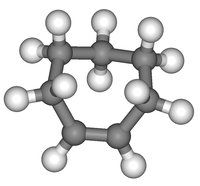- Cycloheptene
-
cis-Cycloheptene[1] 
 (Z)-CyclohepteneOther namescis-Cycloheptene
(Z)-CyclohepteneOther namescis-CyclohepteneIdentifiers CAS number 628-92-2 
PubChem 12363 ChemSpider 11857 
Jmol-3D images Image 1 - C\1=C\CCCCC/1
Properties Molecular formula C7H12 Molar mass 96.17 g/mol Density 0.824 g/cm3 Boiling point 112-114.7 °C
 (verify) (what is:
(verify) (what is:  /
/ ?)
?)
Except where noted otherwise, data are given for materials in their standard state (at 25 °C, 100 kPa)Infobox references Cycloheptene is a 7-membered cycloalkene with a flash point of -7 C°. It is a raw material in organic chemistry and a monomer in polymer synthesis. Cycloheptene can exist as either the cis- or the trans-isomer.
trans-Cycloheptene
With cycloheptene, the cis-isomer is always assumed but the trans-isomer does also exist. One procedure for the organic synthesis of trans-cycloheptene is by singlet photosensitization of cis-cycloheptene with methyl benzoate and ultraviolet light at -35°C.[2] The double bond in the trans isomer is very strained.[3] Part of the steric strain is relieved by pyramidalization of the alkene carbons, the pyramidalization angle is estimated at 37° (compared to a zero angle in an unstrained alkene) and the p-orbital misalignment is 30.1°.[2] Because the barrier for rotation of the double bond in ethylene is approximately 65 kcal/mol (270 kJ/mol) and can only be lowered by the estimated strain energy of 30 kcal/mol (125 kJ/mol) present in the trans-isomer, trans-cycloheptene should be a stable molecule just as its homologue trans-cyclooctene. In fact, it is not; and unless the temperature is kept very low, quick isomerization to the cis-isomer takes place. In a 2005 publication, it is argued that trans-cycloheptene isomerization occurs by an alternative lower energy pathway.[2] Based on the experimentally observed second order reaction kinetics for isomerization, two trans-cycloheptene molecules in the proposed pathway first form a diradical dimer. The two heptane radical rings then untwist to an unstrained conformation and in the final step the dimer is cleaved again into two cis-cycloheptene molecules. Note that the photoisomerization of maleic acid to fumaric acid with bromine is also bimolecular.
References
- ^ Cycloheptene at Sigma-Aldrich
- ^ a b c Michael E. Squillacote, James DeFellipis, and Qingning Shu How Stable Is trans-Cycloheptene? J. Am. Chem. Soc.; 2005; 127(45) pp 15983 - 15988; (Article) DOI: 10.1021/ja055388i Abstract
- ^ D. Cain, D. M. Pawar and E. A. Noe, "Conformational studies of trans-cycloheptene, trans-cycloheptene oxide, and trans-bicyclo [5.1.0] octane by ab initio calculations", Journal of Molecular Structure: THEOCHEM, volume 674, issues 1-3, April 2004, Pages 251-255
External links
Alkenes Dienes Cyclobutadiene · Cyclopentadiene · Cyclohexadiene (1,3-Cyclohexadiene · 1,4-Cyclohexadiene) · Cycloheptadiene · Cyclooctadiene (1,5-Cyclooctadiene)Categories:- Cycloalkenes
- Monomers
Wikimedia Foundation. 2010.

